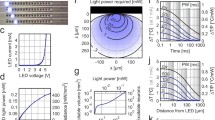Abstract
Photoconductive stimulation allows the noninvasive depolarization of neurons cultured on a silicon wafer. This technique relies on a beam of light to target a cell of interest while applying a voltage bias across the silicon wafer. The targeted cell is excited with minimal physiological manipulation, and, therefore, long-term modulation of activity patterns and investigations of biochemical mechanisms sensitive to physiological perturbations are possible. Ideologically similar to transistor-based neuronal interfaces, the photoconductive-stimulation method has the advantage of being able to extracellularly excite any neuron in a network regardless of its spatial position on the silicon substrate. This protocol can be easily implemented on a conventional reflected-light fluorescence microscope using materials and resources that are readily available. Time requirements are comparable to standard cell-culture and electrophysiology techniques. When combined with fluorescence imaging of various molecular probes, activity-dependent cellular processes can be dynamically monitored.



Similar content being viewed by others
References
Pine, J. Recording action potentials from cultured neurons with extracellular microcircuit electrodes. J. Neurosci. Methods 2, 19–31 (1980).
Gross, G.W., Rhoades, B.K., Azzazy, H.M.E. & Wu, M.C. The use of neuronal networks on multielectrode arrays as biosensors. Biosen. Bioelec. 10, 553–567 (1995).
Maher, M.P., Pine, J., Wright, J. & Tai, Y.C. The neurochip: a new multielectrode device for stimulating and recording from cultured neurons. J. Neurosci. Methods 87, 45–56 (1999).
Kaul, R.A., Syed, N.I. & Fromherz, P. Neuron-semiconductor chip with chemical synapse between identified neurons. Phys. Rev. Lett. 92, 038102 (2004).
Colicos, M.A., Collins, B.E., Sailor, M.J. & Goda, Y. Remodeling of synaptic actin induced by photoconductive stimulation. Cell 107, 605–616 (2001).
Hafeman, D.G., Parce, J.W. & McConnell, H.M. Light-addressable potentiometric sensor for biochemical systems. Science 240, 1182–1185 (1988).
Parak, W.J., Hofman, U.G., Gaub, H.E. & Owicki, J.C. Lateral resolution of light-addressable potentiometric sensors: an experimental and theoretical investigation. Sens. Actuators A Phys. 63, 47–57 (1997).
Miesenbock, G. & Kevrekidis, I.G. Optical imaging and control of genetically designated neurons in functioning circuits. Annu. Rev. Neurosci. 28, 533–563 (2005).
Denk, W. et al. Biological anatomical and functional imaging of neurons using 2-photon laser scanning microscopy. J. Neurosci. Methods 54, 151–162 (1994).
Callaway, E.M. & Yuste, R. Stimulating neurons with light. Curr. Op. Neurobiol. 12, 587–592 (2002).
Tang, X.Y., Gerkin, R.C., Wu, X.L., Goda, Y. & Bi, G.Q. Light-Directed, Patterned Stimulation of Neuronal Networks on Silicon Chips. SFN Annual Meeting, Program No. 920.4 (2004).
Colicos, M.A. & Syed, N.I. Neuronal networks and synaptic plasticity: understanding complex system dynamics by interfacing neurons with silicon technologies. J. Exp. Biol. 209, 2312–2319 (2006).
Starovoytov, A., Choi, J. & Seung, H.S. Light-directed electrical stimulation of neurons cultured on silicon wafers. J. Neurophysiol. 93, 1090–1098 (2005).
Acknowledgements
We thank M. Sailor and B. Collins for their input on the design and troubleshooting of the stimulation device. This work was supported by grants from the National Institute on Drug Abuse (NIDA) and the National Institute of Mental Health (NIMH).
Author information
Authors and Affiliations
Corresponding author
Ethics declarations
Competing interests
The authors declare no competing financial interests.
Supplementary information
Supplementary Movie 1
Fluo-4 calcium imaging of neurons showing spontaneous activity and stimulus-triggered fluorescence changes. Stimulation at 2.5 Hz begins ∼19 s into the movie. The culture is the same as that illustrated in Figure 2. (AVI 1058 kb)
Rights and permissions
About this article
Cite this article
Goda, Y., Colicos, M. Photoconductive stimulation of neurons cultured on silicon wafers. Nat Protoc 1, 461–467 (2006). https://doi.org/10.1038/nprot.2006.67
Published:
Issue Date:
DOI: https://doi.org/10.1038/nprot.2006.67
- Springer Nature Limited
This article is cited by
-
Light-evoked hyperpolarization and silencing of neurons by conjugated polymers
Scientific Reports (2016)
-
p600/UBR4 in the central nervous system
Cellular and Molecular Life Sciences (2015)
-
Inorganic polyphosphate regulates neuronal excitability through modulation of voltage-gated channels
Molecular Brain (2014)
-
A polymer optoelectronic interface restores light sensitivity in blind rat retinas
Nature Photonics (2013)
-
High dose folic acid supplementation of rats alters synaptic transmission and seizure susceptibility in offspring
Scientific Reports (2013)





